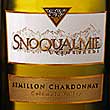 |
|
Wine Details
Price:
Description:
The wine displays fresh citrus and hazelnut aromas with slight herbal notes. The citrus carries through on the palate, and is complimented with soft buttery characters on the finish.
|
|
Varietal Definition
Chardonnay:
Chardonnay is by far the most widely planted grape crop in California and dominates California’s cooler, coastal, quality wine regions. The natural varietal ‘taste and smell’ of Chardonnay is surprisingly unfamiliar to many wine drinkers, as its true character is often guised with dominating winemaking signatures. Chardonnay’s rather subdued primary fruit characteristics lean toward the crisp fruitiness of apples, pears and lemon, but the variety’s full body is capable of supporting a host of complementary characteristics, such as oak, butter and vanilla. Regardless of what is the appropriate style for Chardonnay, the varietal continues to dominate vineyard plantings in every corner of the world. Close attention to clonal selection has made this broad geographic and climactic range of Chardonnay viable in thoughtful viticultural hands.
|
Sémillon:
A thin skinned grape producing wines of high extract and flavour but soft acidity. In France it combines with Sauvignon Blanc to make the white wines of Bordeaux, most notably the sweet dessert wines of Sauternes and Barsac. Its thin skin leaves it susceptible to the fungus botrytis* the much sought after 'noble rot' in these sweet wine regions. As a varietal it has fared best in Australia, notably the Hunter Valley, where it produces well-rounded wines with lots of tropical fruits and honeyed tones. Here too it is blended with Chardonnay and oak aged to give an added dimension.
|
|